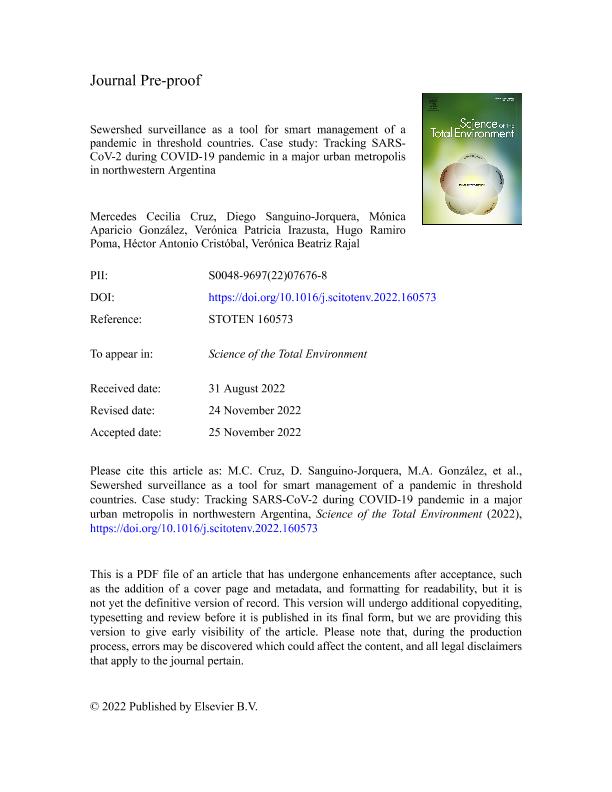Mostrar el registro sencillo del ítem
dc.contributor.author
Cruz, Mercedes Cecilia

dc.contributor.author
Sanguino Jorquera, Diego Gastón

dc.contributor.author
Aparicio González, Mónica Alicia

dc.contributor.author
Irazusta, Verónica Patricia

dc.contributor.author
Poma, Hugo Ramiro

dc.contributor.author
Cristobal, Hector Antonio

dc.contributor.author
Rajal, Verónica Beatriz

dc.date.available
2023-09-11T13:34:44Z
dc.date.issued
2023-03
dc.identifier.citation
Cruz, Mercedes Cecilia; Sanguino Jorquera, Diego Gastón; Aparicio González, Mónica Alicia; Irazusta, Verónica Patricia; Poma, Hugo Ramiro; et al.; Sewershed surveillance as a tool for smart management of a pandemic in threshold countries. Case study: Tracking SARS-CoV-2 during COVID-19 pandemic in a major urban metropolis in northwestern Argentina; Elsevier Science; Science of the Total Environment; 862; 160573; 3-2023; 1-11
dc.identifier.issn
0048-9697
dc.identifier.uri
http://hdl.handle.net/11336/211066
dc.description.abstract
Wastewater-based epidemiology is an economical and effective tool for monitoring the COVID-19 pandemic. In this study we proposed sampling campaigns that addressed spatial-temporal trends within a metropolitan area. This is a local study of detection and quantification of SARS-CoV-2 in wastewater during the onset, rise, and decline of COVID-19 cases in Salta city (Argentina) over the course of a twenty-one-week period (13 Aug to 30 Dec) in 2020. Wastewater samples were gathered from 13 sewer manholes specific to each sewershed catchment, prior to convergence or mixing with other sewer lines, resulting in samples specific to individual catchments with defined areas. The 13 sewershed catchments selected comprise 118,832 connections to the network throughout the city, representing 84.7 % (534,747 individuals) of the total population. The number of COVID19-related exposure and symptoms cases in each area were registered using an application developed for smartphones by the provincial government. Geographical coordinates provided by the devices were recorded, and consequently, it was possible to geolocalise all app-cases and track them down to which of the 13 sampling catchments belonged. RNA fragments of SARS-CoV-2 were detected in every site since the beginning of the monitoring, anticipating viral circulation in the population. Over the course of the 21-week study, the concentrations of SARS-CoV-2 ranged between 1.77 × 104 and 4.35 × 107 genome copies/L. There was a correspondence with the highest viral load in wastewater and the peak number of cases reported by the app for each catchment. The associations were evaluated with correlation analysis. The viral loads of SARS-CoV-2 in wastewater were a feasible means to describe the trends of COVID-19 infections. Surveillance at sewershed scale, provided reliable and strategic information that could be used by local health stakeholders to manage the COVID-19 pandemic.
dc.format
application/pdf
dc.language.iso
eng
dc.publisher
Elsevier Science

dc.rights
info:eu-repo/semantics/openAccess
dc.rights.uri
https://creativecommons.org/licenses/by-nc-nd/2.5/ar/
dc.subject
COVID-19
dc.subject
MONITORING
dc.subject
SALTA COVID APP
dc.subject
SARS-COV-2
dc.subject
WASTEWATER
dc.subject
WASTEWATER-BASED EPIDEMIOLOGY
dc.subject.classification
Bioremediación, Diagnóstico Biotecnológico en Gestión Medioambiental

dc.subject.classification
Biotecnología del Medio Ambiente

dc.subject.classification
INGENIERÍAS Y TECNOLOGÍAS

dc.title
Sewershed surveillance as a tool for smart management of a pandemic in threshold countries. Case study: Tracking SARS-CoV-2 during COVID-19 pandemic in a major urban metropolis in northwestern Argentina
dc.type
info:eu-repo/semantics/article
dc.type
info:ar-repo/semantics/artículo
dc.type
info:eu-repo/semantics/publishedVersion
dc.date.updated
2023-07-07T19:49:47Z
dc.journal.volume
862
dc.journal.number
160573
dc.journal.pagination
1-11
dc.journal.pais
Países Bajos

dc.journal.ciudad
Amsterdam
dc.description.fil
Fil: Cruz, Mercedes Cecilia. Consejo Nacional de Investigaciones Científicas y Técnicas. Centro Científico Tecnológico Conicet - Salta. Instituto de Investigaciones para la Industria Química. Universidad Nacional de Salta. Facultad de Ingeniería. Instituto de Investigaciones para la Industria Química; Argentina
dc.description.fil
Fil: Sanguino Jorquera, Diego Gastón. Consejo Nacional de Investigaciones Científicas y Técnicas. Centro Científico Tecnológico Conicet - Salta. Instituto de Investigaciones para la Industria Química. Universidad Nacional de Salta. Facultad de Ingeniería. Instituto de Investigaciones para la Industria Química; Argentina
dc.description.fil
Fil: Aparicio González, Mónica Alicia. Consejo Nacional de Investigaciones Científicas y Técnicas. Centro Científico Tecnológico Conicet - Salta. Instituto de Investigaciones para la Industria Química. Universidad Nacional de Salta. Facultad de Ingeniería. Instituto de Investigaciones para la Industria Química; Argentina
dc.description.fil
Fil: Irazusta, Verónica Patricia. Consejo Nacional de Investigaciones Científicas y Técnicas. Centro Científico Tecnológico Conicet - Salta. Instituto de Investigaciones para la Industria Química. Universidad Nacional de Salta. Facultad de Ingeniería. Instituto de Investigaciones para la Industria Química; Argentina. Universidad Nacional de Salta. Facultad de Ciencias Naturales; Argentina
dc.description.fil
Fil: Poma, Hugo Ramiro. Consejo Nacional de Investigaciones Científicas y Técnicas. Centro Científico Tecnológico Conicet - Salta. Instituto de Investigaciones para la Industria Química. Universidad Nacional de Salta. Facultad de Ingeniería. Instituto de Investigaciones para la Industria Química; Argentina
dc.description.fil
Fil: Cristobal, Hector Antonio. Consejo Nacional de Investigaciones Científicas y Técnicas. Centro Científico Tecnológico Conicet - Salta. Instituto de Investigaciones para la Industria Química. Universidad Nacional de Salta. Facultad de Ingeniería. Instituto de Investigaciones para la Industria Química; Argentina. Universidad Nacional de Salta. Facultad de Ciencias Naturales; Argentina
dc.description.fil
Fil: Rajal, Verónica Beatriz. Consejo Nacional de Investigaciones Científicas y Técnicas. Centro Científico Tecnológico Conicet - Salta. Instituto de Investigaciones para la Industria Química. Universidad Nacional de Salta. Facultad de Ingeniería. Instituto de Investigaciones para la Industria Química; Argentina. Nanyang Technological University; Singapur
dc.journal.title
Science of the Total Environment

dc.relation.alternativeid
info:eu-repo/semantics/altIdentifier/url/https://www.sciencedirect.com/science/article/pii/S0048969722076768
dc.relation.alternativeid
info:eu-repo/semantics/altIdentifier/doi/http://dx.doi.org/10.1016/j.scitotenv.2022.160573
Archivos asociados
